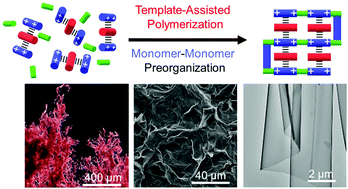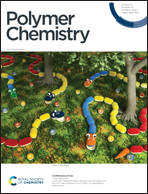Augmented polyhydrazone formation in water by template-assisted polymerization using dual-purpose supramolecular templates†
Abstract
Herein we report an aqueous polymerization strategy, assisted by dual-purpose supramolecular templates, for the formation of polyhydrazones and their subsequent hydrogelation. In this approach, donor–acceptor charge transfer interactions between small molecule templates and bipyridinium-based dialdehyde monomers facilitated monomer–monomer and polymer–monomer preorganization. The template-assisted polymerizations thus experienced augmented Mw and Mn values by up to 68 and 84% respectively as compared to the untemplated protocol. In this capacity, the presence of the templates and the increased molecular weight of the polymers effectively decreased the minimum monomer concentration needed for hydrogelation, enhanced the mechanical strength of the hydrogel microstructure, and increased the recovery velocity of the gel following shear-induced breakdown. The hydrogels were processed into colored films and highly crystalline ultra-light aerogels with a sheet-like morphology, as revealed by cross-polarized light, scanning electron, and transmission electron microscopies. The aerogels exhibited the ability to uptake gaseous iodine and iodine from solution with removal efficiencies and uptake capacities up to ∼91% and ∼363 wt% respectively.

- This article is part of the themed collection: The Mechanics of Supramolecular Chemistry


 Please wait while we load your content...
Please wait while we load your content...